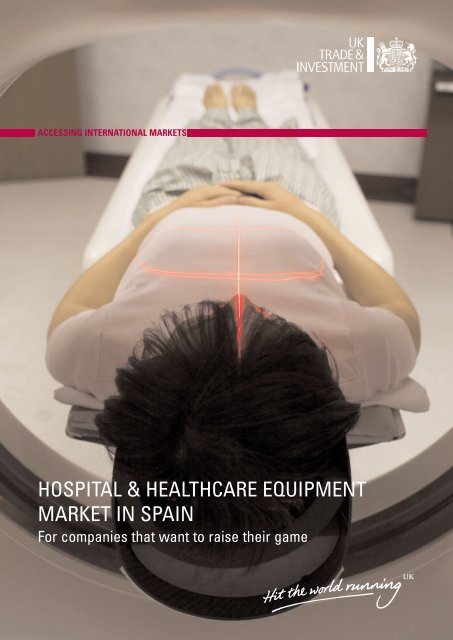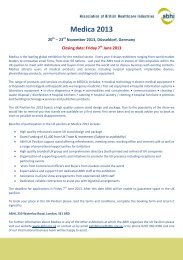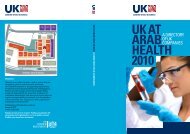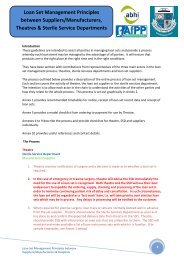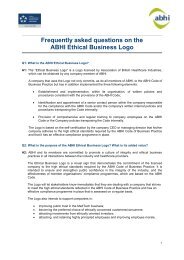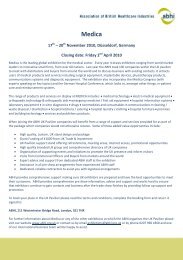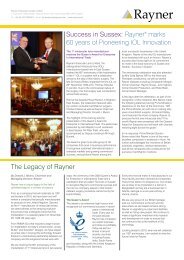hospital & healthcare equipment market in spain - Association of ...
hospital & healthcare equipment market in spain - Association of ...
hospital & healthcare equipment market in spain - Association of ...
Create successful ePaper yourself
Turn your PDF publications into a flip-book with our unique Google optimized e-Paper software.
ACCESSING INTERNATIONAL MARKETS<br />
HOSPITAL & HEALTHCARE EQUIPMENT<br />
MARKET IN SPAIN<br />
For companies that want to raise their game
Contents<br />
Overview & Demographics 2<br />
Healthcare System 4<br />
The <strong>market</strong> for medical <strong>equipment</strong> & supplies 8<br />
Methods <strong>of</strong> do<strong>in</strong>g bus<strong>in</strong>ess 10<br />
Exhibitions 12<br />
ANNEX - Useful Addresses 13 - 16
Overview & Demographics<br />
S<strong>in</strong>ce jo<strong>in</strong><strong>in</strong>g the European Community <strong>in</strong> 1986,<br />
Spa<strong>in</strong> has risen to become the United K<strong>in</strong>gdom’s<br />
7th largest export <strong>market</strong>.<br />
The population <strong>of</strong> about 46.6 million is spread<br />
over a vast area about 2.5 times the size <strong>of</strong> the<br />
UK. Spa<strong>in</strong> is a markedly urban society.<br />
Approximately 20 per cent <strong>of</strong> the population live<br />
<strong>in</strong> cities <strong>of</strong> around 500,000 <strong>in</strong>habitants or more.<br />
The capital, Madrid, with its population <strong>of</strong> around<br />
3 million, is the adm<strong>in</strong>istrative and bus<strong>in</strong>ess<br />
centre <strong>of</strong> the country around which many modern<br />
<strong>in</strong>dustries have grown, and where many large<br />
companies have their headquarters. Barcelona<br />
and Bilbao are also at the heart <strong>of</strong> major areas <strong>of</strong><br />
<strong>in</strong>dustry and commerce. There are also important<br />
bus<strong>in</strong>ess centres <strong>in</strong> other regions, <strong>in</strong>clud<strong>in</strong>g<br />
Valencia, Sevilla, Málaga, Zaragoza, Valladolid<br />
and Vigo.<br />
The population <strong>of</strong> Spa<strong>in</strong> is age<strong>in</strong>g with about 17<br />
per cent (about 7.7 million) <strong>of</strong> the population aged<br />
over 65 years and with a birth rate <strong>of</strong> 1.4 children.<br />
Life expectancy <strong>in</strong> Spa<strong>in</strong> is 83.4 years for women<br />
and 76.9 for men, higher than the EU average. The<br />
percentage <strong>of</strong> the population over 80 years <strong>of</strong> age<br />
<strong>in</strong>creases significantly each year as people live<br />
longer and this now represents about 3.8 per cent<br />
<strong>of</strong> the total population.<br />
Source: INE (Spanish National Statistics Office)<br />
“The population <strong>of</strong> Spa<strong>in</strong> is age<strong>in</strong>g<br />
with 7.7 million aged over 65”<br />
SPANISH HEALTHCARE<br />
2
3 SPANISH HEALTHCARE
Healthcare System<br />
Public<br />
The Spanish National Health System provides<br />
universal health care free at the po<strong>in</strong>t <strong>of</strong> delivery<br />
and when it was set up <strong>in</strong> 1986 it was modelled<br />
on the NHS <strong>in</strong> the UK. The Spanish National<br />
Health System is f<strong>in</strong>anced almost entirely from<br />
taxation and represents an allocation <strong>of</strong> 7.6 per<br />
cent <strong>of</strong> GDP. Statistics on public expenditure <strong>of</strong><br />
public health care can be found at:<br />
http://www.msc.es/estadEstudios/estadisticas/<strong>in</strong>forRecopil<br />
aciones/gastoSanitario/home.htm<br />
Until the end <strong>of</strong> 2001, the central government ran<br />
the Health Service <strong>in</strong> 10 out <strong>of</strong> Spa<strong>in</strong>’s 17 regions<br />
or “autonomous communities” via its body, the<br />
National Health Institute called INSALUD. Six<br />
regions had devolved responsibility for delivery,<br />
though not f<strong>in</strong>anc<strong>in</strong>g, <strong>of</strong> their health services.<br />
The money to f<strong>in</strong>ance the Health Service <strong>in</strong> these<br />
regions came from central government <strong>in</strong> a block<br />
transfer. The 6 regions were Catalonia,<br />
Andalucia, Valencia, Galicia, Navarre and the<br />
Canary Islands. The 7th region with responsibility<br />
for runn<strong>in</strong>g its own health system was the<br />
Basque Country, which for historical reasons,<br />
f<strong>in</strong>ances its public health service from the taxes<br />
it raises with<strong>in</strong> its own region. Although<br />
represent<strong>in</strong>g less than half <strong>of</strong> the regions <strong>in</strong> all <strong>of</strong><br />
Spa<strong>in</strong>, these regions accounted for over 60 per<br />
cent <strong>of</strong> the population. In l<strong>in</strong>e with central<br />
government policy, the transfer <strong>of</strong> responsibility<br />
for <strong>healthcare</strong> to the other regions was<br />
completed, after much debate and delay,<br />
legislation was f<strong>in</strong>ally passed at the end <strong>of</strong> 2001.<br />
Reorganisation <strong>of</strong> these Regional Health<br />
Services with new responsibilities is an on-go<strong>in</strong>g<br />
process. The central government has a<br />
department (the Instituto Nacional de Gestión<br />
Sanitaria) to monitor and evaluate the<br />
function<strong>in</strong>g <strong>of</strong> the health services devolved to all<br />
17 regions <strong>in</strong> Spa<strong>in</strong>. But it should be emphasised<br />
that each region develops its own <strong>healthcare</strong><br />
programme, which <strong>in</strong>cludes their policy for<br />
expansion, <strong>hospital</strong> development and<br />
procurement, and for example, the <strong>in</strong>troduction<br />
and implementation <strong>of</strong> IT technology <strong>in</strong> <strong>hospital</strong>s<br />
and health care centres.<br />
The Government is faced with spirall<strong>in</strong>g costs <strong>in</strong><br />
the provision <strong>of</strong> health services which are<br />
<strong>in</strong>creas<strong>in</strong>g at a higher rate than budget forecasts.<br />
Some <strong>of</strong> the reasons for ris<strong>in</strong>g costs are: (i) As<br />
life expectancy <strong>in</strong>creases, the percentage <strong>of</strong> the<br />
population aged over 65 also rises and the<br />
demands made by this segment on the public<br />
health system are four times greater than the rest<br />
<strong>of</strong> the population, particularly <strong>in</strong> the area <strong>of</strong> 100<br />
per cent reimbursement for pensioner’s<br />
prescription drugs. (ii) The recent wave <strong>of</strong> a new<br />
immigrant population is now also covered under<br />
this universal health system. (iii) Although<br />
decreas<strong>in</strong>g, Spa<strong>in</strong> still has the highest proportion<br />
<strong>of</strong> AIDS cases <strong>in</strong> Europe and this, together with<br />
“Health services devolved<br />
to all 17 Regions <strong>in</strong> Spa<strong>in</strong>”<br />
SPANISH HEALTHCARE<br />
4
drug addiction, presents problems for the public<br />
health system. (iv) Spa<strong>in</strong> is reported to spend<br />
twice as much treat<strong>in</strong>g patients, who come as<br />
tourists from other countries, as it costs other<br />
countries to treat Spanish patients. (v) The<br />
<strong>in</strong>corporation <strong>of</strong> more expensive high technology<br />
<strong>equipment</strong> to detect and treat illnesses is another<br />
factor <strong>in</strong>creas<strong>in</strong>g expenditure.<br />
The Government wants to <strong>in</strong>troduce higher levels<br />
<strong>of</strong> budgetary discipl<strong>in</strong>e and is giv<strong>in</strong>g public<br />
<strong>hospital</strong>s and health centres more f<strong>in</strong>ancial<br />
autonomy. An attempt has been made to set up<br />
<strong>hospital</strong>s as “Trusts” or “Foundations” but this<br />
has met with limited success, <strong>in</strong> cases where a<br />
new <strong>hospital</strong> has been built. So far only a few<br />
“Foundations” have been set up as the subject is<br />
politically very controversial.<br />
PPP (Public Private Partnerships) projects <strong>in</strong> the<br />
<strong>healthcare</strong> sector are flourish<strong>in</strong>g <strong>in</strong> Spa<strong>in</strong>. For<br />
certa<strong>in</strong> regional governments, where lack <strong>of</strong><br />
<strong>hospital</strong>s is an issue, PPP has proved to be a very<br />
important tool for the development <strong>of</strong> new<br />
<strong>hospital</strong>s. The regional government <strong>of</strong> Madrid<br />
used the PPP formula to build and operate 8 new<br />
public <strong>hospital</strong>s rang<strong>in</strong>g <strong>in</strong> size from 120 beds to<br />
700 beds. In 2005 these projects were all put out<br />
to tender and these smaller <strong>hospital</strong>s were<br />
opened by March 2008. Some <strong>of</strong> these <strong>hospital</strong>s<br />
are managed by the public sector and others are<br />
managed by private <strong>healthcare</strong> companies such<br />
as Capio. An announcement <strong>in</strong> 2008 <strong>in</strong>dicated that<br />
“About 7.5 million <strong>of</strong> the<br />
Spanish population are<br />
subscribers to private<br />
health <strong>in</strong>surance”<br />
a further 4 PPP public <strong>hospital</strong>s with private<br />
sector management are planned <strong>in</strong> the Madrid<br />
region. The region <strong>of</strong> Castilla y Leon was<br />
awarded the tender for the PPP project to build a<br />
new <strong>hospital</strong> <strong>in</strong> Burgos and a further 5 PPP<br />
<strong>hospital</strong>s are planned for the region. The Regional<br />
Government <strong>in</strong> Valencia also has plans to build 2<br />
new PPP <strong>hospital</strong>s with the medical and nonmedical<br />
services to be managed by a private<br />
company. The concession for f<strong>in</strong>anc<strong>in</strong>g,<br />
construction, operation and ma<strong>in</strong>tenance <strong>of</strong> a<br />
new 900 bed <strong>hospital</strong> <strong>in</strong> Palma <strong>in</strong> the Balearic<br />
Islands has also been awarded.<br />
There are many other examples <strong>of</strong> <strong>hospital</strong><br />
projects as PPP is be<strong>in</strong>g implemented on an<br />
<strong>in</strong>creas<strong>in</strong>gly larger scale <strong>in</strong> the <strong>healthcare</strong> sector.<br />
The major Spanish construction and service<br />
companies dom<strong>in</strong>ate the <strong>market</strong> and these, along<br />
with the major Spanish banks, are well<br />
connected politically and economically with the<br />
regional authorities. However, foreign companies<br />
and organisations are form<strong>in</strong>g partnerships with<br />
local companies to enter <strong>in</strong>to these PPP<br />
contracts.<br />
In addition to large projects, the current emphasis<br />
is to cont<strong>in</strong>ue with improvements and provision <strong>of</strong><br />
services at primary health care centres.<br />
Reduc<strong>in</strong>g wait<strong>in</strong>g lists is another priority.<br />
Private<br />
About 7.5 million <strong>of</strong> the Spanish population are<br />
subscribers to private health <strong>in</strong>surance schemes<br />
and this figure has <strong>in</strong>creased <strong>in</strong> recent years. 2<br />
million <strong>of</strong> these subscribers are civil servants<br />
and, due to agreements negotiated with their<br />
employer, these subscribers pay reduced<br />
premiums to health <strong>in</strong>surance companies.<br />
Private health <strong>in</strong>surance <strong>in</strong> Spa<strong>in</strong> is a complex<br />
area and is not conf<strong>in</strong>ed to the simple<br />
reimbursement pr<strong>in</strong>ciple. The UK firm BUPA has<br />
a significant <strong>market</strong> share <strong>in</strong> this area through<br />
5 SPANISH HEALTHCARE
their Spanish subsidiary, SANITAS<br />
www.sanitas.es which, <strong>in</strong> 2009, stated they had<br />
40 <strong>hospital</strong>s. Some other lead<strong>in</strong>g companies<br />
<strong>in</strong>clude Adeslas, ASISA, Mafre Caja Salud, DKV.<br />
These health <strong>in</strong>surance firms either adm<strong>in</strong>ister<br />
their own cl<strong>in</strong>ics or determ<strong>in</strong>e the level <strong>of</strong> fees to<br />
be paid to doctors on their panel or <strong>hospital</strong>s<br />
under their schemes.<br />
60 per cent <strong>of</strong> the bus<strong>in</strong>ess <strong>of</strong> “private” <strong>hospital</strong>s<br />
or cl<strong>in</strong>ics comes via the contractual<br />
arrangements the health <strong>in</strong>surance firms have<br />
with these <strong>hospital</strong>s. The rema<strong>in</strong><strong>in</strong>g 40 per cent <strong>of</strong><br />
the <strong>in</strong>come <strong>of</strong> these private <strong>hospital</strong>s comes from<br />
the agreements they have with the Public Health<br />
Service, they use private <strong>hospital</strong> services to<br />
perform surgical processes <strong>in</strong> order to reduce the<br />
public sector wait<strong>in</strong>g lists <strong>of</strong> patients. The length<br />
<strong>of</strong> public sector wait<strong>in</strong>g lists causes concern and<br />
criticism from the public and politicians. It is<br />
<strong>in</strong>terest<strong>in</strong>g to note that subscribers to private<br />
health <strong>in</strong>surance schemes will, more <strong>of</strong>ten than<br />
not, turn to the Public Health Sector for major<br />
operations or treatment. The number <strong>of</strong> Spanish<br />
people prepared to pay for purely private health<br />
treatment is m<strong>in</strong>imal.<br />
Hospital beds<br />
Accord<strong>in</strong>g to the Spanish M<strong>in</strong>istry <strong>of</strong> Health &<br />
Social Policy, as <strong>of</strong> 31 December 2008 there were<br />
804 <strong>hospital</strong>s <strong>in</strong> Spa<strong>in</strong> with 160,983 beds. Tables<br />
giv<strong>in</strong>g statistics <strong>of</strong> <strong>hospital</strong>s and beds by region,<br />
general or specialist centres, public or private,<br />
the high tech <strong>equipment</strong> available, can be seen<br />
on the follow<strong>in</strong>g section <strong>of</strong> the M<strong>in</strong>istry’s web<br />
page under “Catálogo de Hospitales”.<br />
http://www.msc.es/ciudadanos/prestaciones/centrosServici<br />
osSNS/<strong>hospital</strong>es/<strong>in</strong>forEstadistica/home.htm<br />
In summary, 47 per cent <strong>of</strong> the <strong>hospital</strong>s have<br />
between 100 and 500 beds and 9.5 per cent have<br />
over 500 beds. Although on average 70 per cent <strong>of</strong><br />
the <strong>hospital</strong>s are <strong>in</strong> the public sector and 30 per<br />
cent <strong>in</strong> the private sector, this split can vary<br />
accord<strong>in</strong>g to regions. The percentage <strong>of</strong> private<br />
beds is reported to be higher than that figure <strong>in</strong><br />
Catalonia and lower <strong>in</strong> regions as such as<br />
Andalucia and Extremadura. Even though the ratio<br />
<strong>of</strong> <strong>hospital</strong> beds per population is lower than the<br />
EU average, the actual number <strong>of</strong> <strong>hospital</strong> beds<br />
has reduced <strong>in</strong> recent years as the emphasis is<br />
placed on day surgery <strong>in</strong> public health care<br />
centres and out patient sections <strong>of</strong> <strong>hospital</strong>s.<br />
Nurs<strong>in</strong>g homes<br />
Historically, <strong>in</strong> Lat<strong>in</strong> countries such as Spa<strong>in</strong>,<br />
elderly parents are looked after by the family. This<br />
tradition still exists but is chang<strong>in</strong>g slowly as can<br />
be seen by the <strong>in</strong>creased demand for beds <strong>in</strong><br />
nurs<strong>in</strong>g homes <strong>of</strong>fer<strong>in</strong>g assisted care. The latest<br />
figures published <strong>in</strong> January 2007 by IMSERSO,<br />
the Spanish Institute <strong>of</strong> Social Services for the<br />
Elderly, <strong>in</strong>dicate that for the total population <strong>of</strong> 7.5<br />
million aged over 65, there were 4,839 nurs<strong>in</strong>g<br />
homes. Only 35 per cent <strong>of</strong> these were <strong>in</strong> the<br />
public sector (either public or contracted from<br />
the private nurs<strong>in</strong>g home sector). The total<br />
number <strong>of</strong> 298,870 beds is low by EU standards.<br />
The ratio <strong>of</strong> beds per 100 people aged over 65 is<br />
about 4 per cent. Reports <strong>in</strong>dicate that well over<br />
90,000 elderly people are on the wait<strong>in</strong>g list for a<br />
bed <strong>in</strong> a public sector nurs<strong>in</strong>g home and for that<br />
reason, long term care elderly patients <strong>of</strong>ten<br />
occupy beds <strong>in</strong> public <strong>hospital</strong>s.<br />
SPANISH HEALTHCARE<br />
6
Real estate developers and construction<br />
companies have seen the opportunity that exists<br />
for the development <strong>of</strong> nurs<strong>in</strong>g homes and also<br />
private sheltered hous<strong>in</strong>g <strong>in</strong> flats for the<br />
<strong>in</strong>dependent elderly. Growth <strong>in</strong> this sector is<br />
rapid. For example, it was reported <strong>in</strong> the press<br />
<strong>in</strong> 2008 that Sanitas are currently operat<strong>in</strong>g 38<br />
nurs<strong>in</strong>g homes, with 5 more <strong>in</strong> different stages <strong>of</strong><br />
construction (see www.sanitasresidencial.com )<br />
Local sav<strong>in</strong>gs banks and venture capital<br />
companies have also provided f<strong>in</strong>ance to some<br />
nurs<strong>in</strong>g home developers.<br />
Ambulance Services<br />
There has been a vast improvement <strong>in</strong> the quality<br />
<strong>of</strong> ambulance services <strong>in</strong> Spa<strong>in</strong> <strong>in</strong> the past 10<br />
years. Fully equipped mobile <strong>in</strong>tensive care vans<br />
with tra<strong>in</strong>ed paramedics on board appear quickly<br />
at the scene <strong>of</strong> an accident. These <strong>in</strong>tensive care<br />
ambulances are usually operated by the regional<br />
and local health authorities, the city council or<br />
municipal services <strong>in</strong> co-ord<strong>in</strong>ation with the<br />
police. The Red Cross also has its own fleet <strong>of</strong><br />
<strong>in</strong>tensive care ambulances as well as<br />
ambulances for the transfer <strong>of</strong> patients. It is quite<br />
common to see that a lead<strong>in</strong>g bank, lead<strong>in</strong>g<br />
company or a private health <strong>in</strong>surance firm has<br />
acted as a sponsor by provid<strong>in</strong>g the f<strong>in</strong>ance for<br />
these ambulances. Private ambulance services<br />
also exist to transfer patients from their homes to<br />
<strong>hospital</strong>s or to rehabilitation centres for treatment<br />
- the public health services reimburses the cost<br />
<strong>of</strong> this service.<br />
7 SPANISH HEALTHCARE
The <strong>market</strong> for medical <strong>equipment</strong> & supplies<br />
The Spanish <strong>market</strong> for medical <strong>equipment</strong> and<br />
supplies is ranked 5th <strong>in</strong> the EU-25 and 9th <strong>in</strong> the<br />
world. The Spanish M<strong>in</strong>istry <strong>of</strong> Health & Social<br />
Policy published an <strong>in</strong>terest<strong>in</strong>g table on their<br />
website show<strong>in</strong>g the high tech <strong>equipment</strong><br />
<strong>in</strong>stalled <strong>in</strong> <strong>hospital</strong>s <strong>in</strong> each region <strong>in</strong> Spa<strong>in</strong>,<br />
<strong>equipment</strong> such as CAT & MIR, lithotripers and<br />
mammography mach<strong>in</strong>es.<br />
http://www.msc.es/ciudadanos/prestaciones/centrosServici<br />
osSNS/<strong>hospital</strong>es/<strong>in</strong>forEstadistica/equiposATecnologia.jsp<br />
Reports <strong>in</strong>dicate that about 85 per cent <strong>of</strong><br />
electro-medical <strong>equipment</strong> is imported. 51 per<br />
cent <strong>of</strong> these imports comes from the EU (ma<strong>in</strong>ly<br />
Germany, Italy and France), 26 per cent from the<br />
USA and 15.3 per cent from Japan. 80 per cent<br />
<strong>of</strong> the <strong>market</strong>’s requirements for <strong>hospital</strong><br />
disposable or s<strong>in</strong>gle use supplies are imported,<br />
ma<strong>in</strong>ly from the Far East <strong>in</strong> bulk or from USA<br />
parent companies by their Spanish subsidiaries.<br />
UK brands <strong>of</strong> medical <strong>equipment</strong> and other<br />
supplies, <strong>in</strong>clud<strong>in</strong>g disposable items, are sold <strong>in</strong><br />
the Spanish <strong>market</strong>. Spa<strong>in</strong> does have some<br />
product areas where local manufacture is<br />
significant e.g. medical and <strong>hospital</strong> furniture,<br />
textile products (bandages, gauze, uniforms,<br />
orthopaedic corsets) and <strong>in</strong> the assembly <strong>of</strong><br />
certa<strong>in</strong> types <strong>of</strong> medical apparatus.<br />
The EU Directive on the CE mark<strong>in</strong>g for<br />
medical devices has been transposed <strong>in</strong>to<br />
Spanish legislation.<br />
The <strong>healthcare</strong> supplies <strong>market</strong> <strong>in</strong> Spa<strong>in</strong> is<br />
becom<strong>in</strong>g <strong>in</strong>creas<strong>in</strong>gly dom<strong>in</strong>ated by the<br />
subsidiaries <strong>of</strong> the major mult<strong>in</strong>ational<br />
companies. Nevertheless, experienced local<br />
distribution companies exist both at a national<br />
and regional level. Importers and distributors, as<br />
well as local manufacturers and the products and<br />
brands they sell, can be identified by access<strong>in</strong>g<br />
the web site for the “Guia Puntex” trade<br />
directories <strong>in</strong> the health care sector.<br />
www.puntex.es<br />
Source: FENIN (National Federation <strong>of</strong> Companies deal<strong>in</strong>g<br />
<strong>in</strong> Scientific Instruments, Medical, Technical & Dental<br />
Equipment)<br />
SPANISH HEALTHCARE<br />
8
“ The Spanish <strong>market</strong> for<br />
medical <strong>equipment</strong> and<br />
supplies is ranked 5th <strong>in</strong> the<br />
EU-25 and 9th <strong>in</strong> the world”<br />
9 SPANISH HEALTHCARE
Methods <strong>of</strong> do<strong>in</strong>g bus<strong>in</strong>ess<br />
If a foreign supplier <strong>of</strong> medical and <strong>hospital</strong><br />
<strong>equipment</strong>, <strong>equipment</strong> for the disabled or elderly<br />
etc, wishes to do bus<strong>in</strong>ess <strong>in</strong> Spa<strong>in</strong>, they must<br />
appo<strong>in</strong>t a distributor or agent. It is important to<br />
note that distribution arrangements are different<br />
for medical <strong>equipment</strong> requir<strong>in</strong>g after sales<br />
service than for disposable or s<strong>in</strong>gle use medical<br />
supplies. For example, a foreign supplier <strong>of</strong><br />
electro-medical <strong>equipment</strong> usually appo<strong>in</strong>ts a<br />
s<strong>in</strong>gle distributor for all <strong>of</strong> Spa<strong>in</strong>. This distributor<br />
would have branch <strong>of</strong>fices <strong>in</strong> other major cities<br />
throughout Spa<strong>in</strong> or appo<strong>in</strong>t sub-distributors or<br />
dealers to cover other areas.<br />
This network is essential <strong>in</strong> order to sell to the<br />
Regional Health Services that like to deal with<br />
companies that speak their regional language<br />
and that are close to hand to provide prompt after<br />
sales service and repair work. In the case <strong>of</strong><br />
<strong>hospital</strong> disposable or s<strong>in</strong>gle use items, it is<br />
common for foreign firms to have several local<br />
distributors/wholesalers throughout the country.<br />
Purchas<strong>in</strong>g for public sector <strong>hospital</strong>s and health<br />
care centres is done through calls for tender.<br />
These tenders are regulated by the EU Directives<br />
on public procurement which were transposed<br />
<strong>in</strong>to Spanish legislation some years ago. The role<br />
<strong>of</strong> a local distributor is essential as these locallybased<br />
firms f<strong>in</strong>d out about the tenders before<br />
they are drawn up and published, purchase the<br />
tender specifications, arrange a bid <strong>in</strong> Spanish or<br />
the regional language and submit a bid bond <strong>in</strong><br />
Euros arranged through a local bank to the tender<br />
board on behalf <strong>of</strong> the foreign pr<strong>in</strong>cipal. Doctors<br />
and senior medical services staff are key<br />
decision makers when purchas<strong>in</strong>g requirements<br />
are drawn up and the staff from the local<br />
distributor’s <strong>of</strong>fice must frequently visit these key<br />
contacts. Sometimes <strong>equipment</strong> may be left on<br />
trial <strong>in</strong> a <strong>hospital</strong> by the local distributor free <strong>of</strong><br />
charge <strong>in</strong> the hope that a need be created and a<br />
tender prepared. It may take 12 to 18 months from<br />
the time the local distributor presents a new<br />
product until the time that the tender is published<br />
and awarded, so foreign suppliers should not<br />
expect immediate results.<br />
A “Consortium” was set up by the Catalan<br />
Regional Health Service to <strong>of</strong>fer private<br />
management services to the public health service<br />
there. This service <strong>in</strong>cludes organis<strong>in</strong>g bulk<br />
purchases <strong>of</strong> disposable medical supplies to<br />
obta<strong>in</strong> the best price, the preparation <strong>of</strong> tender<br />
documents, the management <strong>of</strong> tender<br />
procedures and advice on plann<strong>in</strong>g purchases<br />
and <strong>equipment</strong>. In the Valencia Region a central<br />
purchas<strong>in</strong>g unit exists.<br />
Payments <strong>in</strong> the public sector vary widely<br />
accord<strong>in</strong>g to regions. The Basque Region Health<br />
Service is renowned for be<strong>in</strong>g the best payers i.e.<br />
with<strong>in</strong> 60 to 90 days. The Navarre Region pays<br />
with<strong>in</strong> a similar period <strong>of</strong> time. Improvements <strong>in</strong><br />
“Key drivers creat<strong>in</strong>g<br />
bus<strong>in</strong>ess opportunities<br />
are: ag<strong>in</strong>g population,<br />
patient and cl<strong>in</strong>ician<br />
demands, <strong>in</strong>novative and<br />
high tech products which<br />
save time & resources”<br />
SPANISH HEALTHCARE<br />
10
the management systems <strong>in</strong> public <strong>hospital</strong>s <strong>in</strong><br />
other regions have meant that the length <strong>of</strong> time<br />
for payments to be made has been shortened e.g.<br />
<strong>in</strong> the Madrid Region payment delays vary from<br />
90 to 120 to 180 days. In Catalonia and the<br />
Valencia Region payment delays are from 6<br />
months to one year. In Andalucia payment delays<br />
can be slightly longer than this.<br />
Private <strong>hospital</strong>s and nurs<strong>in</strong>g homes buy from<br />
local distributors or suppliers and request best<br />
bids from several firms when buy<strong>in</strong>g supplies. A<br />
private health <strong>in</strong>surance firm may present the<br />
“private” <strong>hospital</strong> <strong>in</strong>corporated <strong>in</strong>to their scheme<br />
with the names <strong>of</strong> the <strong>hospital</strong> disposable<br />
supplies they will reimburse and a set low price<br />
with the recommendation that the private <strong>hospital</strong><br />
purchase this brand.<br />
Equipment for the disabled and elderly is sold<br />
through orthopaedic shops sell<strong>in</strong>g a variety <strong>of</strong><br />
items and <strong>equipment</strong>. Orthopaedic corsets and<br />
prosthetics are fitted <strong>in</strong> many <strong>of</strong> these shops by<br />
qualified staff. Reimbursement for the cost <strong>of</strong> aids<br />
for the disabled by the government depends on<br />
the degree <strong>of</strong> disability. It is estimated that there<br />
are 1,700 orthopaedic retail outlets <strong>in</strong> Spa<strong>in</strong>.<br />
Details and web pages <strong>of</strong> major organisations<br />
<strong>in</strong>volved <strong>in</strong> the sector <strong>of</strong> <strong>equipment</strong> and services<br />
for the disabled and elderly are given <strong>in</strong> the Annex<br />
<strong>of</strong> Useful Addresses at the end <strong>of</strong> this report.<br />
11 SPANISH HEALTHCARE
Exhibitions<br />
There are numerous small exhibitions for<br />
specialised <strong>equipment</strong> associated with national and<br />
<strong>in</strong>ternational medical congresses held <strong>in</strong> Spa<strong>in</strong>. For<br />
example, if a national congress for cardiologists is<br />
held then a small exhibition <strong>of</strong> <strong>equipment</strong>/devices<br />
used <strong>in</strong> this speciality takes place <strong>in</strong> the space or<br />
corridors outside the conference hall. Sometimes<br />
these “small exhibitions” can have as many as 30<br />
exhibitor’s stands.<br />
http://www.msc.es/pr<strong>of</strong>esionales/socCientificas/especial<br />
idades.htm<br />
Orprotec – the International Trade Fair for<br />
Orthopaedics and Assisted Liv<strong>in</strong>g and Technology<br />
for the Disabled and Elderly is held <strong>in</strong> Valencia<br />
every two years. Contacts <strong>in</strong> the trade say that<br />
this event is becom<strong>in</strong>g <strong>in</strong>creas<strong>in</strong>gly important<br />
with exhibitors and visitors com<strong>in</strong>g from all over<br />
Spa<strong>in</strong>. It is considered a suitable venue for British<br />
firms want<strong>in</strong>g to see what is available <strong>in</strong> this area<br />
<strong>of</strong> the <strong>market</strong>. The last event took place from 29th<br />
November to 1st December 2007. An event called<br />
SEPROMA, with exhibits <strong>of</strong> services and products<br />
for nurs<strong>in</strong>g homes and for the elderly, was held at<br />
the same time. The next event will be held from<br />
26th to 28th November 2009.<br />
http://orprotec.feriavalencia.com<br />
Orto ProCare is held <strong>in</strong> Madrid on alternate years.<br />
The last event was held at IFEMA trade fair<br />
centre, Madrid, from 27th to 29th November 2008<br />
to co<strong>in</strong>cide with the National Congress for<br />
Orthopaedic Technicians and the Congress for<br />
Nurs<strong>in</strong>g Therapy and Care. This was the 3rd time<br />
this event had been held.<br />
www.orto-procare.com<br />
Email: <strong>in</strong>fo@hf-spa<strong>in</strong>.com<br />
Avante shows products and services for the<br />
elderly to improve the quality <strong>of</strong> life and<br />
<strong>in</strong>dependent liv<strong>in</strong>g, and was held for the first time<br />
<strong>in</strong> 2008, and the 2nd event will be held <strong>in</strong> June<br />
2010. Further <strong>in</strong>formation is available <strong>in</strong> English on<br />
the organiser’s web site, <strong>in</strong>clud<strong>in</strong>g a list <strong>of</strong><br />
exhibitors:<br />
http://www.salonavante.com/en/visitants_llistat.html<br />
Spanish distributors <strong>of</strong> health care <strong>equipment</strong> are<br />
regular visitors to the important “Medica” trade fair<br />
as well as to “Rehacare”, both held <strong>in</strong> Düsseldorf.<br />
SPANISH HEALTHCARE<br />
12
13 SPANISH HEALTHCARE
ANNEX - Useful Addresses<br />
MINISTERIO DE SANIDAD Y POLITICA SOCIAL<br />
(M<strong>in</strong>istry <strong>of</strong> Health & Social Policy)<br />
Paseo del Prado 18-20<br />
28014 MADRID<br />
Tel: +34 91 596 1000<br />
Fax: +34 91 596 4480<br />
Email: oiac@msc.es<br />
Web: www.msc.es<br />
Comment: For statistical <strong>in</strong>formation on different<br />
aspects <strong>of</strong> <strong>healthcare</strong> <strong>in</strong> Spa<strong>in</strong> - see<br />
http://www.msc.es/estadEstudios/estadisticas/ba<br />
ncoDatos.htm<br />
IMSERSO – Instituto de Mayores y<br />
Servicios Sociales<br />
Avenida de la Ilustración s/n<br />
Con vuelta a Calle G<strong>in</strong>zo de Limia 58<br />
28029 MADRID<br />
Tel: +34 91 363 8916<br />
Web: http://www.seg-social.es/imserso &<br />
http://www.imsersomayores.csic.es<br />
www.saad.mtas.es for <strong>in</strong>formation on the<br />
Dependence Law (Law 39/2006)<br />
CEAPAT – CENTRO ESTATAL DE AUTONOMIA<br />
PERSONAL Y AYUDAS TECNICAS<br />
Los Extremeños 1<br />
28018 MADRID<br />
Tel: +34 91 363 4800<br />
Fax: +34 91 778 4117<br />
Email: ceapat@mtsa.es<br />
Web: www.ceapat.org<br />
Comment: Centre belong<strong>in</strong>g to the M<strong>in</strong>istry <strong>of</strong><br />
Health & Social Policy where <strong>in</strong>formation on<br />
technical help and aids for the disabled and<br />
elderly is available. Has an area where<br />
<strong>equipment</strong> is on display.<br />
CATSALUT - SERVEI CATALÀ DE LA SALUT<br />
Travessera de les Corts 131-159<br />
Edifici Olímpia<br />
08028 BARCELONA<br />
Tel: +34 93 403 85 85<br />
Fax: +34 93 403 89 25<br />
Web:<br />
http://www10.gencat.net/catsalut/<br />
eng/coneix.htm<br />
Comment: CatSalut is the public body responsible<br />
for <strong>healthcare</strong> <strong>in</strong> Catalonia.<br />
SPANISH HEALTHCARE<br />
14
INSTITUT CATALÀ D’ASSISTÈNCIA I SERVEIS<br />
SOCIALS (ICASS)<br />
Generalitat de Catalunya<br />
Departament de Benestar Social<br />
Plaza de Pau Vila, 1<br />
Palau de Mar<br />
08039 BARCELONA<br />
Tel: + 34 93 483 1000 / 1742<br />
Fax: +34 93 483 1222<br />
Email: bdgicass@correu.gencat.es<br />
Web: www.gencat.es/benestar<br />
Comment: This Institute is part <strong>of</strong> the Department<br />
<strong>of</strong> Social Welfare at the Catalan Government and<br />
provides <strong>in</strong>formation and advice on technical help<br />
and aids for the disabled/elderly. They manage a<br />
series <strong>of</strong> programmes to adapt homes to the<br />
needs <strong>of</strong> the disabled, assist <strong>in</strong> their adaptation to<br />
the home and workplace, etc. The Centre for<br />
Innovation and Development (SIRIUS) is one <strong>of</strong><br />
the sections <strong>of</strong> ICASS. They analyse, promote and<br />
co-ord<strong>in</strong>ate the <strong>in</strong>troduction <strong>of</strong> new technologies<br />
to assist <strong>in</strong> accessibility and <strong>in</strong>dependent liv<strong>in</strong>g.<br />
They also provide guidance and tra<strong>in</strong><strong>in</strong>g on how<br />
to meet the specific needs <strong>of</strong> the disabled. The<br />
Centre has a display area for products such as<br />
mobility aids, liv<strong>in</strong>g and communication aids<br />
which local manufacturers or distributors leave<br />
on loan.<br />
FEDERACION NACIONAL DE CLINICAS PRIVADA<br />
(National Federation <strong>of</strong> Private Hospital)<br />
Pr<strong>of</strong>esor Waksman 5 – 1º<br />
28036 MADRID<br />
Tel: +34 91 458 5765<br />
Fax: +34 91 458 5766<br />
Email: <strong>in</strong>fo@fncp.<strong>in</strong>fo<br />
Web: http://www.fncp.<strong>in</strong>fo/<br />
Comment: More than 200 private <strong>hospital</strong>s and 5<br />
regional associations belong to this Federation.<br />
ASOCIACION MADRILEÑA DE RESIDENCIAS DE<br />
LA TERCERA EDAD<br />
Y CENTROS DE DIA<br />
(Madrid <strong>Association</strong> <strong>of</strong> Private Nurs<strong>in</strong>g Homes<br />
and Day Centres for the Elderly)<br />
Travesía de P<strong>in</strong>zón 5, Local<br />
28025 MADRID<br />
Tel: +34 902 221 722<br />
Fax: +34 91 466 5425<br />
Email: amrte@amrte<br />
Web: www.amrte.es<br />
FNM - FEDERACION NACIONAL DE CENTROS Y<br />
SERVICIOS DE MAYORES<br />
(National Federation <strong>of</strong> Private Nurs<strong>in</strong>g Homes &<br />
Services for the Elderly)<br />
La Rambla 75, Pr<strong>in</strong>cipal<br />
08002 BARCELONA<br />
Tel: +34 93 301 8015<br />
Fax: +34 93 301 4153<br />
Email: fnrpte@fnrpte.com<br />
Web: www.fnrpte.com<br />
AESTE – ASOCIACION ESTATAL DE EMPRESAS<br />
DE SERVICIOS DE RESIDENCIAS PARA LA<br />
TERCERA EDAD<br />
(<strong>Association</strong> <strong>of</strong> companies <strong>of</strong>fer<strong>in</strong>g services to<br />
Nurs<strong>in</strong>g Homes)<br />
Rodríguez San Pedro 2, 6 Ofic<strong>in</strong>a 612<br />
28015 MADRID<br />
Tel/Fax: +34 91 448 6130<br />
Email: asana@asociacion-aeste.es<br />
Web: www.asociacion-aeste.es<br />
Comment: <strong>Association</strong> <strong>of</strong> 13 lead<strong>in</strong>g nurs<strong>in</strong>g home<br />
groups <strong>in</strong> Spa<strong>in</strong> with 6 founder members.<br />
Member companies listed on web site. These<br />
members manage 344 homes for the elderly,<br />
which <strong>in</strong>cludes 41,921 beds, as well as 5,344<br />
places <strong>in</strong> day care centres for the elderly.<br />
15 SPANISH HEALTHCARE
ACRA - ASOCIACION CATALANA<br />
DE RECURSOS ASISTENCIA<br />
Travessera de Gracia 40, pr<strong>in</strong>cipal 2<br />
08021 BARCELONA<br />
Tel: + 34 93 414 7552<br />
Fax: +34 93 414 6526<br />
Email: acra@acra.es<br />
Web: www.acra.es<br />
Comment: Non-pr<strong>of</strong>it mak<strong>in</strong>g association which<br />
provides advice for companies runn<strong>in</strong>g<br />
residential homes for the elderly <strong>in</strong> Catalonia.<br />
ACRA can advise on legislation for nurs<strong>in</strong>g homes<br />
<strong>in</strong> Catalonia and is apparently used as a<br />
reference po<strong>in</strong>t when other regional governments<br />
want to draft their legislation.<br />
FENIN – Federación Nacional de Empresas de<br />
Tecnología Sanitaria<br />
(National Federation <strong>of</strong> Companies deal<strong>in</strong>g <strong>in</strong><br />
Scientific Instruments, Medical, Technical &<br />
Dental Equipment)<br />
Juan Bravo 10, 3<br />
28006 MADRID<br />
Tel: +34 91 575 9800<br />
Fax: +34 91 435 3478<br />
Email: <strong>in</strong>fo@fen<strong>in</strong>.es<br />
Web: www.fen<strong>in</strong>.es<br />
Comment: Major trade association.<br />
GUIAS PUNTEX (Puntex guides)<br />
Padilla 323<br />
08025 BARCELONA<br />
CIDAT – CENTRO DE INVESTIGACION,<br />
DESARROLLO Y APLICACION TIFLOTECNICA<br />
Cam<strong>in</strong>o Hormigueras 172<br />
28031 MADRID<br />
Tel: +34 91 709 7600<br />
Fax: +34 91 709 7777<br />
Email: cidat@once.es<br />
Web: www.once.es/cidat<br />
Comment: CIDAT belongs to the ONCE –<br />
Organización Nacional de los Ciegos (equivalent<br />
to National Institute for the Bl<strong>in</strong>d). They carry out<br />
research, develop and import products for the<br />
bl<strong>in</strong>d. Sales outlets <strong>in</strong> 33 ONCE centres <strong>in</strong> the<br />
ma<strong>in</strong> towns <strong>in</strong> Spa<strong>in</strong>. The ONCE’s ma<strong>in</strong> objective<br />
is to provide employment and better liv<strong>in</strong>g<br />
environments for the bl<strong>in</strong>d, partially bl<strong>in</strong>d or those<br />
people with some form <strong>of</strong> physical or mental<br />
disability. The ONCE has an extensive website<br />
with English option.<br />
SEIS -SOCIEDAD ESPAÑOLA DE<br />
INFORMATICA DE LA SALUD<br />
(Spanish <strong>Association</strong> for IT <strong>in</strong> Health)<br />
CEFIC - Secretaria Técnica de la SEIS<br />
Enrique Larreta 5<br />
28036 - MADRID<br />
Tel: +34 91 388 94 78 / 79<br />
Fax: +34 91 388 94 79<br />
Email: cefic@cefic.com<br />
Web: www.seis.es<br />
Tel: +34 93 446 2820<br />
Fax: +34 93 446 2064<br />
Email: puntex@puntex.es<br />
Web: www.puntex.es<br />
Comment: Publish Anuario Hospitalario Español<br />
(Spanish Hospital Supplies Directory) as well as a<br />
number <strong>of</strong> directories cover<strong>in</strong>g different areas <strong>of</strong><br />
health care supplies e.g. Traumatology &<br />
Orthopaedics Supplies, Gerontology Supplies,<br />
Laboratory & Cl<strong>in</strong>ical analysis, etc.<br />
SPANISH HEALTHCARE<br />
16
A range <strong>of</strong> UK Government support is available from a portfolio <strong>of</strong> <strong>in</strong>itiatives called<br />
Solutions for Bus<strong>in</strong>ess. The “solutions” are available to qualify<strong>in</strong>g bus<strong>in</strong>esses, and cover<br />
everyth<strong>in</strong>g from <strong>in</strong>vestment and grants through to specialist advice, collaborations and<br />
partnerships.<br />
UK Trade & Investment is the government organisation that helps UK-based companies<br />
succeed <strong>in</strong> the global economy. We also help overseas companies br<strong>in</strong>g their high<br />
quality <strong>in</strong>vestment to the UK.<br />
UK Trade & Investment <strong>of</strong>fers expertise and contacts through its extensive network <strong>of</strong><br />
specialists <strong>in</strong> the UK, and <strong>in</strong> British embassies and other diplomatic <strong>of</strong>fices around the<br />
world. We provide companies with the tools they require to be competitive on the<br />
world stage.<br />
For more <strong>in</strong>formation regard<strong>in</strong>g UK Trade & Investment services please visit<br />
www.uktrade<strong>in</strong>vest.gov.uk or contact:<br />
Kerry Farrell - Senior Trade & Investment Adviser<br />
British Embassy Madrid<br />
Tel: +34 917 146 334<br />
E-mail: Kerry.Farrell@fco.gov.uk<br />
Whereas every effort has been made to ensure that the<br />
<strong>in</strong>formation given <strong>in</strong> this document is accurate, neither UK<br />
Trade & Investment nor its parent Departments (the<br />
Department for Bus<strong>in</strong>ess, Innovation and Skills (BIS), and the<br />
Foreign & Commonwealth Office), accept liability for any<br />
errors, omissions or mislead<strong>in</strong>g statements, and no warranty is<br />
given or responsibility accepted as to the stand<strong>in</strong>g <strong>of</strong> any<br />
<strong>in</strong>dividual, firm, company or other organisation mentioned.<br />
Published September 2009 by UK Trade & Investment<br />
© Crown Copyright.


